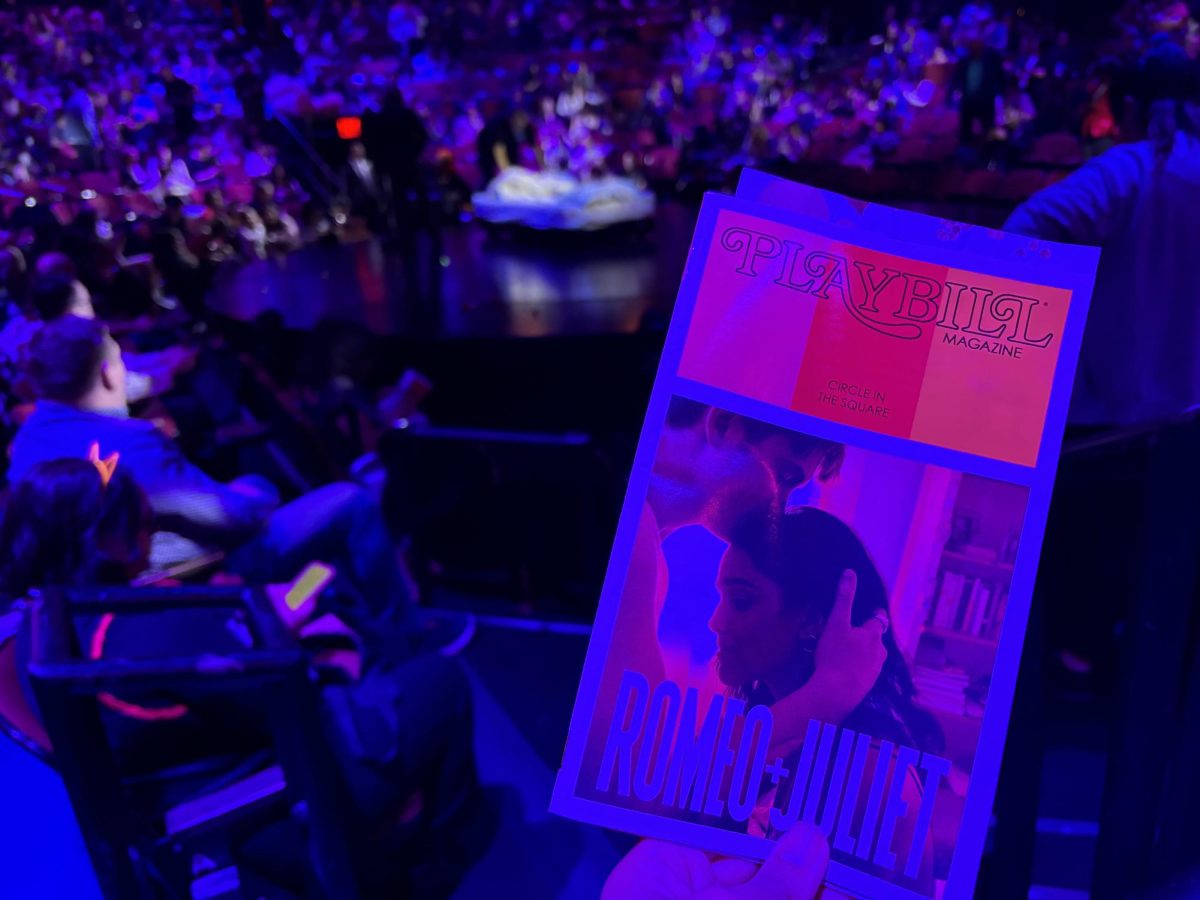Years after I first read “Romeo and Juliet” in high school, I never thought pastel teddy bears and synth music by Jack Antonoff would help me further understand the line “for never was a story of more woe, than this of Juliet and her Romeo.”
On Oct. 24, director Sam Gold’s revival of “Romeo + Juliet” opened on Broadway, starring young acting sensations Kit Connor and Rachel Zegler in their Broadway debuts.
The tale of Shakespeare’s “Romeo and Juliet” is the classic star-crossed lovers story. The dangerous feud between the Montagues and Capulets has been recreated and reimagined countless times. According to the New York Theatre Guide, Gold’s production is the play’s 37th revival on Broadway.
A DJ stands in the back playing the synthy, electropop tracks of Antonoff. It’s quite easy to forget that this is supposed to be Verona, Italy.
The aesthetics of this modern version are stark, bold and bright. Across promotional material, Connor, Zegler (playing Romeo and Juliet, respectively) and the rest of the cast were captured in color-filtered, somewhat grainy photos paired with simple, saturated text. It made the production feel more like a 21st century coming-of-age indie film rather than a 16th century Shakespearean play. The tagline “The Youth Are F**ked” is displayed across the website, social media and other promotional material.
Descending into the Circle in the Square Theatre, a saturated red glow illuminates the audience. There’s a muted bass booming in the background as cast members quietly enter the stage one by one. They mess around with the random props on stage: a shopping cart filled with stuffed toys, an inflatable lounge chair and a pack of water bottles.
The play commences with a rager-esque dance party introducing the cast and their roles. A DJ stands in the back playing the synthy, electropop tracks of Antonoff. It’s quite easy to forget that this is supposed to be Verona, Italy.
Despite the modernization, the production was able to maintain the poetic, tragic sorrow of the original love story while shining light on its often overlooked role as a cautionary tale about hate and negligence.
That feeling is most noticeable in the costumes, designed by Enver Chakatash. The entire cast wears trendy, bright streetwear. Mercutio (Gabby Beans), Romeo’s close friend, sports baggy jeans and a tank top. Juliet’s arranged fiance, Paris (Gían Pérez), wears a T-shirt that says “Gift of God.” Juliet often wears Doc Martens and dons a strappy, glittery dress to the Capulet’s party in Act 1.
Little to no changes were made to the original script itself. Gold did not incorporate smartphones or a random social media scene, making the time and setting somewhat blurred. This version of “Romeo + Juliet” is ragingly Gen Z. The cast spoke and acted Shakespeare with the mannerisms of a young modern adult. It amusingly changed the delivery of lines like “Come, we burn daylight, ho!”
Despite the modernization, the production was able to maintain the poetic, tragic sorrow of the original love story while shining light on its often overlooked role as a cautionary tale about hate and negligence. Romeo and Juliet meet a tragic end in the original play because their parents were too busy feuding and kept deciding for their own children.
Gold’s production is partly a testament to the timelessness of Shakespeare’s “Romeo and Juliet,” but his vision for this production made it all the more prominent and framed it in a way appealing to a younger and wider audience.
Notably, “Romeo and Juliet” has over 20 speaking roles, but this version consists of only 10 cast members. Many of the roles are played by the same actor. For instance, Beans also plays the neutral Friar Laurence, who acts as an emcee. Tybalt and Juliet’s nurse are played by Tommy Dorfman. Lady and Lord Capulet pretty much become the same character, with Sola Fadiran portraying both. They all play their roles brilliantly, but there are little visual and acting distinctions between characters, blurring the line of who’s who. At one point, Beans explicitly declares that she’s the Friar now as she steps on stage.
These maneuvers were somewhat confusing, but this casting places more attention and emphasis on the two lovers themselves and their tragedy. Romeo and Juliet were two teenagers left on their own. While the tale largely follows their romance, their love story also serves as a warning to what can happen when the youth are neglected in a violent world. Tragedy and misery unfold.
Connor’s performance as Romeo was phenomenal. Perhaps it is because I have already seen him as a young golden retriever boyfriend in “Heartstopper,” in “Romeo + Juliet,” he embodies a young, sincere, wide-eyed lover boy again. During the iconic balcony scene, he eagerly runs up and down and around the theater, passionately soliloquizing his love for Juliet. The viral pull-up he does on her suspended bed to kiss her cements his commitment to Juliet and his character.
The only part that brought me out of the dreamy, poetic mood were the production’s two original pop songs, both sung by Juliet. The first one was arguably fitting, taking place at the Capulet’s party when Romeo first meets Juliet. The second one takes place right after Romeo is exiled for killing Tybalt. As Romeo is lamenting his banishment, Juliet comes out on stage and sings a slow pop ballad about her admiration and love for him. While Zegler is an amazing singer and played Juliet wonderfully, it felt like this track was forced in.
Gold’s “Romeo + Juliet” is a fresh take on a centuries-old tale, serving as an introduction to Shakespeare for some audiences by providing a new breath to a classic.
“Romeo + Juliet” will have a 20-week run on Broadway, with its final performance taking place on Feb. 16, 2025


